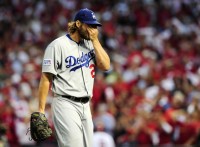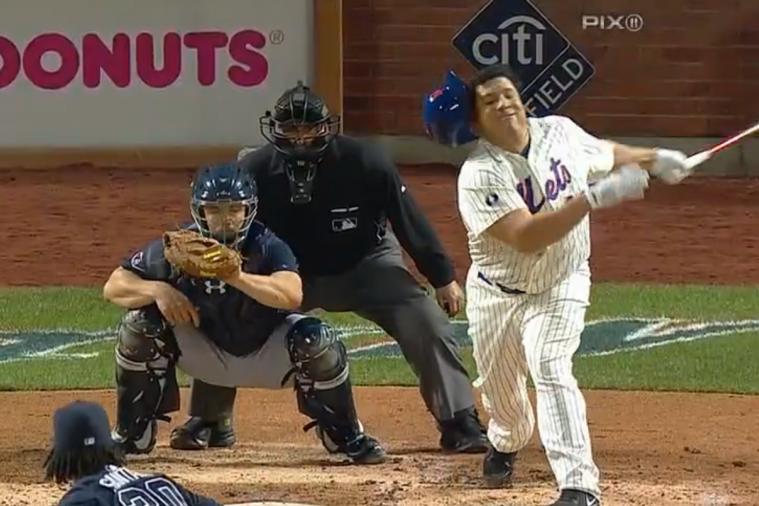Rants

Look, Clayton Kershaw is the best pitcher on the planet right now, and he could shut out the ’27 Yankees. Last night, the Mets trotted out a lineup that isn’t even as good as the ’62 Mets. The Mets had three position players in the lineup below the Mendoza line. In all seriousness, Kershaw has to be kicking himself for not getting the perfect game.
Sadly, after Thursday’s press conference, I don’t think anyone in the Mets front office is kicking themselves for letting the season slip away. Earlier this year, New York Post columnist Mike Vaccaro stated the Mets were committing malpractice. He was being kind. This is either incompetence or indifference. Considering the skills of the front office people, I believe it’s the later.
I understand putting Michael Cuddyer out there when he wasn’t producing. You have to assume he will eventually revert back to form. Furthermore, the Mets roster is shallower than the Caddy Shack pool. Only this tIme, that’s not a Baby Ruth. Rather, it’s a bench complete with players under the Mendoza Line.
Cuddyer has been hurt since June 30th. At the time, Cuddyer knew it was bad. It’s almost a full month later, and he’s still not in the DL. In St. Louis, he couldn’t play a full game. The Mets tell us they have money and are looking to make moves, but it simply just isn’t true. Also, we keep hearing Michael Conforto isn’t ready and Kyle Schwarber is an outlier. He might be. He might not be. Regardless, they have to try something. They’ve effectively been playing with a 24 man roster for a month!
This loss is strictly on Sandy Alderson. We criticize players who make a gaff and don’t make themselves available to reporters. Sandy hides behind Terry every game. That, like his roster, is embarrassing . . . almost as embarrassing as Kershaw letting up three hits tonight.

Scott Kazmir is in the news again, and yet again, it makes Mets fans want to tear their hair out. First, he was inexplicably traded for Victor Zambrano. Then, we were enlightened how the Mets drafting of Kazmir symbolized yet again how bad the Mets front office was. Now, he’s the first player traded at a time when Mets fans have been begging the front office to do anything to help this offense.
It’s also notable this trade was completed by fellow 1962 expansion franchise Houston Astros. Much like the Astros, the Mets are competing ahead of schedule. Unlike the Mets, the Astros have made a move AND maybe looking to make more. Mets fans hear they won’t pick the remaining portion of Ben Zobrist’s salary. It’s disheartening. However, the good news is that apparently the market was set low with only lower-end A ball prospects being traded.
Maybe this trade will launch the Mets into action. There are already rumblings Michael Conforto will be called-up. I suspect they may start being tied to some players. Hopefully, they can pull the trigger on a deal.
Did you ever hear of the saying, the more things change the more they stay the same? The saying drives me absolutely nuts. Inherently, something that is static cannot also be idle at the same time. However, for the first time I am starting to understand this saying.
I believe this season is starting to resemble 2005. Sure there was some optimism before that season with the signings of Carlos Beltran and Pedro Martinez. This was also going to be the first full season David Wright and Jose Reyes were going to play together. That team also had some holes: Doug Mientkiewicz had a great glove but not the bat to play 1B, Kaz Matsui was being shifted to play 2B after he showed he couldn’t play SS the prior year, and let’s not forget the closer was Braden Looper in a largely ineffective bullpen. However, I don’t know of anyone that expected the Mets to realistically make the playoffs that year.
At that point, the Mets fans were suffering. In 2001, the Mets rallied around the city, but they fell short of making the playoffs in an otherwise disappointing season. In 2002, we watched Steve Phillips attempt to recreate the team as an offensive juggernaut with the likes of Mo Vaughn, Roberto Alomar, Jeromy Burnitz, and Roger Cedeno. This lead to three years of just bad baseball. Now, the Mets fans were clamoring for a move to be made. We wanted to see Piazza go out on his last year with the Mets with a winner. At the Trading Deadline, the Mets found themselves only 4 games out of the Wild Card.
However, Omar Minaya stayed the course. The Mets made no trades. He kept his bullets for the offseason. If you recall, that was a magical offseason with the additions of Paul LoDuca, Carlos Delgado, Jose Valentin, Xavier Nady, Endy Chavez, Julio Franco, Pedro Feliciano, Duaner Sanchez, John Maine, Jorge Julio (was was then traded in season for El Duque), Darren Oliver, and Billy Wagner. Omar showing restraint permitted the Mets to build that great 2006 team the fans loved.
Now, Mets fans have been suffering longer than they were in 2005, and they are begging for just one bat (which I don’t think will do the trick). While Mets fans were disappointed in 2005, I don’t remember them being a distraught as they are now. I think the difference is trust. We trusted that ownership and Omar would spend the money to get the players that were needed. In fact, they just come off of a spending spree that netted Pedro and Beltran. Now, fans don’t trust that ownership will spend the money. I believe this is the trust gap that is the biggest sense of frustration with this team.
It’s a shame too because I remember 2005 being a fun season. So far, I think 2015 has been gut-wrenching with all the tight, low-scoring games. My only hope is that if the Mets don’t make a move now, they have a plan for what can be realistically accomplished this summer. There will be LF available who can really help the team in the short term, but the market is scarce on middle infielders. My fingers are crossed. I want to be able to go to a playoff game with my father and son.
The reason I started this blog was to share my experiences as a dad trying to raise his son a Mets fan. For the first time yesterday, I began to realize how difficult this task is.
I wanted to take a my lunch break to sit down and watch a portion of the Mets-Nationals game. I decided to go around 1:00 because I figured: 1) there may be less people and 2) the establishment would be changing the channel at this time in case they got the start time confused (it was a camper’s special 12:35 start).
I couldn’t believe my eyes when I walked in at 1:30. Not one TV was turned to the Mets game. This is the most important game the Mets have played in 8.5 years, and no one could be bothered. The TV set-up was as follows: two on ESPN News, two on generic soccer (sorry all the European leagues are the same to me), and one on NBA TV showing a game from the 80’s.
Normally, I would’ve asked them to change the channel, but I just hurried out to my car (whenever they change the channel in these places it takes 5 minutes longer than it should). Thank God Howie and Josh do such a great job on radio that it really is a viable option. However, no offense to Howie and Josh, I wanted to watch some of the game. I didn’t realize that was going to be a challenge due to the popularity of classic NBA games.
I’m still going to watch as many Mets games as I can. I’m still going to watch the games with my son. The question is will I only be able to do it in the comfort of my home in the future? I hope not.
No, this is not a post regarding the Mets inability to obtain more offense while being in the middle of a pennant. Rather, this is more about somehow Mets fans were ranked #27 in all of baseball. At first, my eyes popped out of my head. I couldn’t believe it. Apparently, there were others who shared in my disbelief. While, I don’t necessarily share some of Jayson’s Starks conclusions, specifically that “Mets fans ought to rank below Yankees fans,” I think he is correct that the data is skewed.
Note, this is not meant to be a hack job on the person who wrote the piece. Obviously, the writer put some time and effort into this, and I do not think she deserves to be torn to shreds. However, when analysis like hers is put out there, I do believe the work should invite some scrutiny. In order to be fair, I decided to not only look at the factors, but also the raw data (which does not include the formulas to compute the raw data).
My first issue was the selection of 2014 as a basis for Power Rankings. By their very nature, Power Rankings are supposed to be a current picture of the teams in a sport. Notably for the Mets, the team has seen an increase in attendance from 2014. I’m sure this rise will have an impact on the 2015 Power Rankings, but then we will be in 2016, which will be a much different year than 2015 was.
My second issue is the selection of average attendance as a percentage of stadium capacity. The major flaw here is that the numbers are not weighted or adjusted for the home ballparks. Fenway Park is reported to have a capacity of 37,673, which is one of the lowest in baseball. Meanwhile, Dodger Stadium has a capacity of 56,000, which is the largest in baseball. How do you reconcile these numbers especially when the Dodgers play in a two team geographical area and when teams are known for manipulating attendance figures? What I also don’t know if the figures were predicated upon sales or “turnstyle” data.
My third issue is the secondary market criteria. The author presents the information as being driven by demand without explaining how or why that is. While I agree demand is one factor, it is not the only factor. This also forgets average ticket prices. The Red Sox, Yankees, and Cubs have the highest average ticket prices. Therefore, naturally, the resale of these tickets will go for a higher price because the people selling these tickets want to gain a profit, or at a minimum, break even. Next, the secondary market price is driven by the team performance. A 2014 ticket for the Mets in September was not as in demand as a ticket for the Royals. The Royals were competing for the second Wild Card; the Mets’ season had been over for months. Also, I did not see how this secondary price was presented in the raw data (although admittedly a smarter person than I could probably explain to me where it was reflected).
My fourth issue is the use of Forbes annual team revenue as a factor. This relies on Forbes’ valuation model without fully knowing what goes into Forbes’ model. In fact, did you know that one of the Yankees’ revenue generators is the ownership of the YES Network? I don’t see how the value of the YES Network should factor into analysis of who is the best fans in baseball. Also, profits from jersey sales are not a factor in the computation of team value. Accordingly, if your team leads in jersey sales, it is not reflected anywhere in team revenue and/or popularity. To be fair, the author stated she weighed this lower than the ticket sales information, but how low? We don’t know that.
The fifth, final, and biggest issue was the percentage of social media fans as a percentage of the metro area population. First and foremost, how is the metropolitan areas defined? Was the Yankees metropolitan area just the Bronx or did it include all 5 boroughs, upstate New York, and Northern New Jersey? Was all of New England incorporated into the metropolitan area for Red Sox Nation? How was San Jose treated in this analysis vis-a-vis the Giants and the Athletics. Also, when there are two teams in a metro area population, how was the data weighted? It’s easy to dominate a metro area when you’re the Reds and you’re the only show in town. Indeed, the data shows the Reds have a 85.15% Twitter following (however that 85.15% is derived – seriously I don’t think 85.15% of the twitter accounts in Cincinnati follow the Reds). However, it should be noted, these same Reds only have a Facebook percentage of 49.63%. Now the data does seem to bear out teams generally have a higher percentage of Twitter followers than Facebook followers, but why? Is there something to be said about a team’s social media activity and the percentage of followers? Furthermore, as the San Jose controversy shows teams not only have their local metro area rights, but they also have other geographic rights. Are the metro area and geographic areas one in the same? We don’t know from this analysis.
Overall, I don’t know if there is a better way to calculate “MLB Fan Power Rankings” other than what the author did here. The reason for that is because there really is no good method. Even though I don’t know of a better method, I do question why certain data was omitted. For example, I don’t know why something like ratings wasn’t included on this list. Isn’t it important whether a city ACTUALLY WATCHES ITS TEAM PLAY? Furthermore, is there any relevance as to what ESPN and Fox selects as its nationally televised games. Their selections are based upon ratings, which are based upon factors such as popular teams, players, and fanbases who watch their team. Also, why wasn’t any the data adjusted for team performance? Looking at the last link regarding ratings, there is a snippet there which shows as the Mets have improved this year, there was a “27% growth in viewership for prime time games over last season.” I also question why the same websites’ criteria is different for the NFL than it is the MLB? There was nothing in these rankings regarding total attendance. Since this analysis was performed across different sports by the same website, I also find it interesting there wasn’t a sport to sport analysis. For example, the Steelers were found to be the fifth most engaged, whereas the Pirates’ fans were ranked eighth. Does this have any meaning at all?
Overall, I am not going to be an obnoxious like Cardinal fans and declare that Mets fans are the best in baseball (let’s see them hit hard times and find out what happens to their fandom). However, I refuse to accept the Mets are 27th based upon flawed criteria. While I am not a Mets fan obsessed with retaking New York, I have more faith in Mets fans than to dismiss them as one of the worst in baseball.
